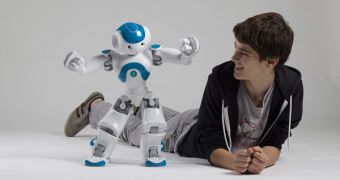French startup Aldebaran Robotics just announced the next-generation version of the Nao robot that is meant to interact with humans and assist organizations that care for people with disabilities (autistic children and other conditions).
Mostly, Nao Next Gen is intended for research, teaching and generally exploring the new area of service robotics.
The original Nao only sold 2,000 models worldwide, but Aldebaran no doubt wants Nao Next Gen to do better.
“The inception of this new generation of NAO robots means a lot to our company. We are proud to be in a position to provide our customers with endless options, whatever their sector,” states Bruno Maisonnier, founder and chairman of Aldebaran Robotics.
“With NAO Next Gen coming of age, we shall be able to make it serve organisations that care for autistic children and those losing their autonomy. I created Aldebaran Robotics in 2005 with this aim: to contribute to humankind’s well-being.”
The humanoid robot has a pair of HD video cameras for eyes and uses Nuance voice recognition, plus a better walking algorithm and smart torque control.
With the above to give better interaction and body coordination, an Intel Atom CPU with a clock speed of 1.6 GHz does the computing.
At the end of the day, Nao Next Gen should be able to perform fast face and object recognition even in low lighting conditions and generally work better than its predecessor.
“On top of this new hardware version, we shall be delivering new software functionalities like smart torque control, a system to prevent limb/body collisions, an improved walking algorithm, and more,” Maisonnier says.
“We have capitalised upon our experience and customer feedback in order to deliver the most suitable and efficient platform. In terms of applications especially at high-school level, we are focused on educational content, while, when it comes to improvements in personal well-being, we are working on developing specialized applications.”

 14 DAY TRIAL //
14 DAY TRIAL //